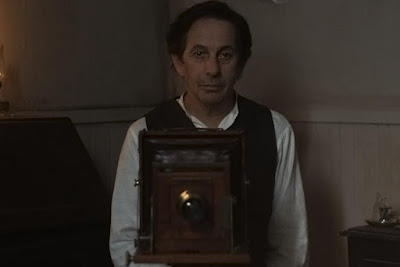Blanco en Blanco in Venice Horizons section
 |
| Blanco en Blanco © La Biennale di Venezia |
By Moira Sullivan
Blanco en Blanco is an extraordinary film which debuted in the Horizons section of the Venice Film Festival Sept 3 directed by Spanish/Chilean director Théo Court. Apart from the opening scenes, the film is about molestation and murder of young Indian women in the Tierra del Fuego archipelago that lies between Argentina and Chile. The opening seen of Blanco en Blanco Court shows a beautiful landscape of plains and frozen earth. Away from the mountains the snow is melting on a settlement with sparse makeshift cabins.
We see the instruments of early daguerreotype photography and the reverence that the main character and the filmmaker holds for these inventions and instruments is evident. The stark realism of this scene is highly crafted by cinematographer José Alayón who takes beautiful moving pictures and stills– for example when the photographer sits in a beige painted wood paneled room with a small window and a small candle on the table. The way the still shots are constructed and snapped at the time by a photographer involved a countdown of several seconds.
The 60-year-old photographer (Chilean actor Alfredo Castro) takes a photograph of a young girl of 10 or 11 and positions her in an alluring way to please the client who has ordered the photograph and paid for it, an older man who is the landowner. He is going to marry her. The photographer falls in love with her and he wonders if his client wants his photograph taken too since this is a new commission for him. The gaze of the photographer is apparent throughout the film with the young girl, the landscape, shots of the settlement and artistically arranged shots of genocide of the indigenous Selk'nam women. More distressing are the men in the village who are alcoholic and violent who also want their pictures taken. We first discover women of the Selk'nam people are being molested and asked to wear western clothing. The stark realism of this seemingly beautiful area is ravaged by the landowner and his men who are mining the area for gold.
Director Theo Court says the story is based on the Argentine engineer Julius Popper who was responsible for the genocide of the Selk’nam and took photographs of his conquests of Tierra del Fuego in the 1880s. The photographer develops a sense of guilt not for the young girl he is in love with but the women. The senseless acts of the men later are turned into a photo shoot that the photographer meticulously arranges of dead women lying on the ground.
It is hard to not think of the first mobile camera was a shotgun and the oft heard command "Take the shot".
For a minute I thought I was watching Pans Labyrinth – the atrocities so horrible that a retreat into the world of fantasy is the only relief when a mythical feature covered with white short feathers walks by the photographer .
© 2019 - Moira Sullivan- Air Date: 09/25/19
Movie Magazine International
Movie Magazine International
Comments
Post a Comment